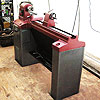As an introduction to this thread, it is NOT the intent to start any sort of "WHO makes the best tool!"
In fact, this thread is an effort to thwart that type of post, by relating why various factors might suit the individual needs of a particular turner vs. why they may not for another turner.
The fact is, there are many fine tools being made, and for a variety of reasons one or more may or may not suit your turning needs. I thought it might be interesting to explore what those reasons might be.
I would encourage you to add comments from your personal experiences that contribute information that might be beneficial to viewers.
It might also be helpful if you state which tools work best for you, BUT including WHY is most important. That type of information is helpful to folks that are seeking information - perhaps beginners trying to figure out which tool to buy, and even to experienced turners that are just beginning to consider other tools.
What will NOT be helpful is a blanket statement that a particular manufacturer makes the best tools available. That is simply not a true statement, for the reasons discussed, and is NOT helpful.
There are many factors to consider - flute design, machining, etc., and one often discussed is the metal used. To start out the discussion, I will post some general comments on metal qualities extracted from the CPM site - http://www.crucible.com/eselector/ge...eraltitle.html These qualities help define WHY a particular gouge might be more suited to your style of turning.
"Toughness
* Ability to resist chipping or breakage. Several factors influence toughness, including : amount of carbon in solution, the hardness the steel is heat treated to, the carbide size and volume, and the other alloy in solution. Carbide size and volume are probably the greatest controlling factors for toughness. High amounts of chromium weaken grain boundaries, although for stainless steels carbide size and volume are the limiting factor. Nickel and silicon in moderate amounts increase toughness without affecting strength.
Wear Resistance
* The ability to resist abrasive wear. Highly important property for slicing type cutting, especially when slicing abrasive materials like rope and cardboard, but less important in general when it comes to slicing soft, less abrasive materials, in which case edge stability, strength, and toughness are more important for holding an acute, polished edge. For the slicing cuts, if the edge is relatively thick wear resistance is more beneficial. Generally greater wear resistance means the steel is more difficult to sharpen, so even if a knife can benefit from a steel of greater wear resistance, less wear resistance may be preferred for easier resharpening."
Speed, aggressiveness and the type of wood turned are all important. If the wood has a lot of silica content, then those particles will tend to abrade the edge of the tool with minute fractures, leaving a microscopically rough edge. Rock inclusions in a piece of root will do a number on a hard, more brittle tool, but might not damage as much the edge of a tougher tool. Tool tip mileage is also important when it comes to wear. In turning a typical bowl, someone like Reed Gray who can/will take off a ½" thick layer of wood with each pass will put far less mileage on the cutting area of his gouge, than will someone like me that tends to be far less aggressive.
The following table on the CPM site is helpful, as well.
CPM 15V CPM 15V CPM 15V CPM 10V CPM M4 D2 D7
This is an excerpt from one of the data sheets on the CPM site –
CPM DATA CHART.jpg
D-Way uses M42 Cobalt steel and Dave states he heat treats to R67-68. The following typical alloy content was found at http://www.westyorkssteel.com/tool-s...eed-steel/m42/
Carbon 1.05% Silicon 0.35% Tungsten 1.50% Chromium 3.75% Vanadium 1.15% Molybdenum 9.50% Cobalt 8.00%
And, from http://www.hudsontoolsteel.com/technical-data/steelM4, the following:

Regarding any type of "proprietary" metal used by a manufacturer, it would be helpful if the manufacturer had publicly provided similar information, even if they did not choose to disclose the alloy content of the metal. That would alleviate guesswork about the metal characteristics of the tool and diminish possible skepticism about the claims of the manufacturer.
Sooooo.....what characteristics do you desire in a gouge and why? Or, what additional information would you think helpful to others considering a new tool purchase?





 Reply With Quote
Reply With Quote





